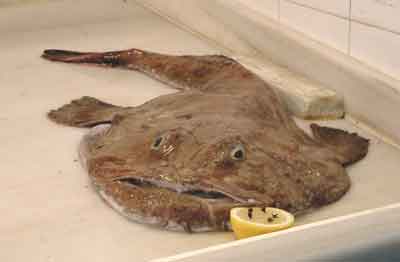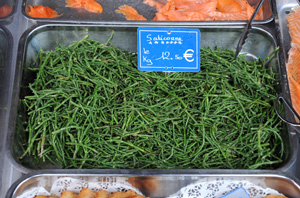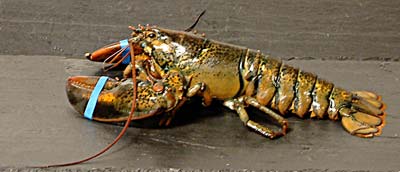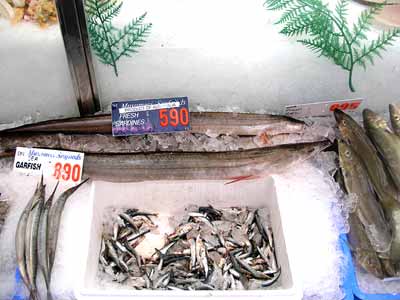Bleak. A small, elongated, white-fleshed fish, abundant in lakes and quiet waterways. Its scales, which are thin and silvery, come away easily. The flesh of the pond bleak is of poor quality, but that of the river variety is fairly good, though full of little bones. It is about 15 cm (6 inches) long and invariably served fried.

Monkfish (US: angler fish). A fish with a sweet flavour and succulent firm flesh but with the ugliest appearance imaginable. It is found in the Mediterranean and Atlantic, in coastal waters of north western Europe. It can be recognised by its large head and fan-shaped fins. The fins and the operculum are spiny. It can be eaten fried or in soup. The larger fish often have better flavour. It has a hideous head, which is why it is usually displayed without it, and a muddy colour. It is known as the anglerfish as it bears on its head a 'rod' and 'lure' which attract its prey. The meat of the tail is sweet and succulent - almost like lobster meat, entirely compensating for is appearance. The flavour may well be assisted by its own diet which is high in shellfish. The best monkfish are Lophius piscatorius and the similar Lophius budegassa, the favourite of the Spanish. American monkfish or goosefish (Lophius americanus) is considered inferior, while New Zealand monkfish (Kathetostoma giganteum) is related to the stargazer and is only fit for soup.

Samphire (US: sea bean). A fleshy plant which grows on rocks near the sea. Can be used as a salad green or as a cooked vegetable. It has a short season and is not a cultivated crop, so it is quite uncommon. It may be pickled in white wine vinegar with a little sugar.

Lobster. The European lobster is a large, marine shellfish with huge claws and is dark, mottled blue-black before cooking, turning red during the process. The flesh is sweet and tender. The Maine or American lobster found in the United States is huge in size and lacks the wonderful sweetness of its European cousin. American varieties may sometimes be brick red before cooking. In Europe they are likely to up to 2 kg (4¼ lbs) while North American ones may be a lot larger. Increasingly, American lobsters are imported for use in Europe.

Conger eel, sea eel. The crustaceans and fish which form its diet contribute to its own good flavour. It is usually sold in steaks. It has few bones and good firm flesh with excellent flavour. The neck end has a better ratio of flesh to bone so is better for cooking as steaks, whereas the tail end, which is bonier, makes a useful addition to soups and stocks.